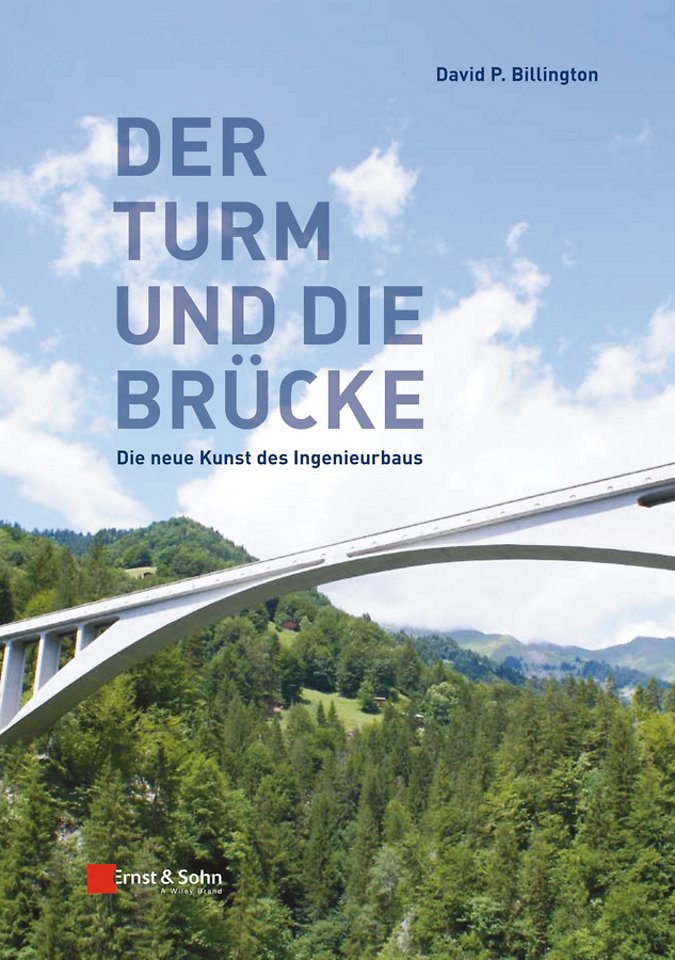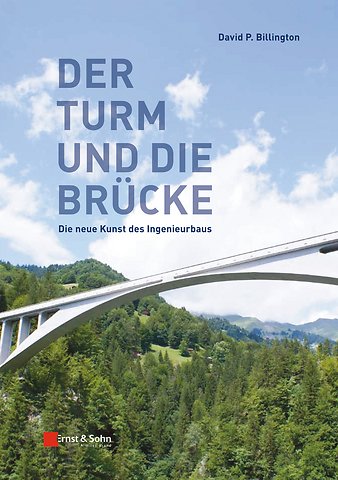Der Turm und die Brücke – Die neue Kunst des Ingenieurbaus
Die neue Kunst des Ingenieurbaus
Paperback Duits 2013 9783433030776Samenvatting
Long recognised as a classic in the USA, "The Tower and the Bridge" is now at last available in German translation. In his preface to the German edition, Jörg Schlaich writes. "This book is essential reading and a pleasure for the "structural engineering artist", in whose structures the connection between form and force flow is visible and which are distinguished by the ideals of efficiency, cost–effectiveness and elegance."
Billington founded with this book structural art as a new, independent art form, which he considers equivalent to architecture. It is no coincidence that the title states the two classic domains of the structural engineer; in this case Billington is referring to two outstanding structures of the epoch, the Eiffel Tower and the Brooklyn Bridge.
Billington describes in an easily readable style and in an entertaining manner the ideals, principles and methods of structural art during its historical development through examples of structures from outstanding engineers (e.g. Telford, Maillart, Freyssinet, Menn).
With the establishment of structural art as an art form and the explication of its inherent principles, Billington gives the reader well founded arguments for the aesthetic discussion of engineering structures. This also provides a basis for criticism of the new art form; for the criticism of construction that has long been demanded. This timeless book thus has the potential to give a new impulse to the debate about construction culture and particularly the aesthetic aspects of structural engineering in German–speaking countries.
Specificaties
Lezersrecensies
Inhoudsopgave
<p>Vorwort XI</p>
<p>1 Eine neue Tradition: Kunst im Ingenieurbau 1</p>
<p>Eine neue Kunstform</p>
<p>Die Ideale der Structural Art</p>
<p>Die Geschichte der Structural Art</p>
<p>Ingenieurbau und Wissenschaft</p>
<p>Bauwerke und Maschinen</p>
<p>Ingenieurbau und Architektur</p>
<p>Die drei Dimensionen von Bauwerken</p>
<p>Structural Art und die Gesellschaft</p>
<p>Teil 1 Das Zeitalter des Eisens</p>
<p>2 Thomas Telford und die neue Kunstform 23</p>
<p>Die zweite Eisenzeit</p>
<p>Thomas Telford und die Kunst der Brücke</p>
<p>Telford und die Grenzen des konstruktiv Machbaren</p>
<p>Kunst und Politik</p>
<p>Telfords Ästhetik</p>
<p>Wissenschaft und Ingenieurbau</p>
<p>3 Brunel, Stephenson und die Eisenbahn 39</p>
<p>Das Problem der Form</p>
<p>Robert Stephenson</p>
<p>Isambard Kingdom Brunel</p>
<p>Die Spannung zwischen Structural Art und Wirtschaft</p>
<p>Brunel und Stephenson</p>
<p>4 Gustave Eiffel und der Sichelbogen 53</p>
<p>Ein Turm und eine Ausstellung</p>
<p>Ingenieurbauwerk und Architektur</p>
<p>Gustave Eiffel</p>
<p>Der Crystal Palace von 1851 und die Pariser Weltausstellung 1867</p>
<p>Große Weiten, große Höhen</p>
<p>Die erste Sichelbogenbrücke: Douro</p>
<p>Die zweite Sichelbogenbrücke: Garabit</p>
<p>5 John Roebling und die Hängebrücke 64</p>
<p>Brunel und Roebling</p>
<p>Immigrant und Ingenieur</p>
<p>Roebling und die Grenzen des konstruktiv Machbaren</p>
<p>Die Ohio River Bridge</p>
<p>Roeblings Ideale</p>
<p>6 Die Brücke und der Turm 75</p>
<p>Höhepunkt und Aufklärung</p>
<p>Die Funktion folgt der Form</p>
<p>Die Kostenunsicherheit</p>
<p>Wirtschaftlichkeit und Kreativität</p>
<p>Structural Art und der Künstler</p>
<p>Vorläufige Gedanken zu Structural Art</p>
<p>Teil 2 Das neue Zeitalter von Stahl und Beton</p>
<p>7 Jenney und Root: Die erste Chicagoer Schule 89</p>
<p>Bürotürme</p>
<p>Gotik als Nostalgie</p>
<p>Wolkenkratzer und Kathedralen</p>
<p>Die erste Chicagoer Schule</p>
<p>William Le Baron Jenney</p>
<p>John Wellborn Root</p>
<p>Root und Sullivan</p>
<p>8 Große Stahlbrücken von Eads bis Ammann 101</p>
<p>Wolkenkratzer und Brücken</p>
<p>Chicago gegen St. Louis: Die Eads Bridge</p>
<p>Die Brücke über den Firth of Forth</p>
<p>Der Übergang: Gustav Lindenthal</p>
<p>Die Hell Gate Bridge</p>
<p>Moderne Formen aus Stahl: Othmar Ammann</p>
<p>Die George Washington Bridge</p>
<p>Wissenschaft und Konstruktion</p>
<p>Hell Gate und Bayonne</p>
<p>Zwei Visionen: Ammann und Steinman</p>
<p>9 Robert Maillart und neue Formen in Stahlbeton 135</p>
<p>Der Werkstoff des 20. Jahrhunderts</p>
<p>Deutsche Wissenschaft, französische Industrie</p>
<p>Die Schweizer Synthese</p>
<p>Robert Maillart</p>
<p>Neue Formen für Brücken</p>
<p>Neue Formen für Gebäude</p>
<p>10 Dachgewölbe und nationale Stile 157</p>
<p>Die Vorstellungskraft des Ingenieurs und lokale Traditionen</p>
<p>Dischinger, Finsterwalder und die deutsche Schule</p>
<p>Nervi und die italienische Tradition</p>
<p>Die spanische Schule: Gaudí, Torroja und Candela</p>
<p>Candela und die Tugend der Schlankheit</p>
<p>11 Eugène Freyssinets Leitgedanke 179</p>
<p>Ein neues Material</p>
<p>Eugène Freyssinet</p>
<p>Die Anfänge der Vorspannung in der freien Natur</p>
<p>Le Veurdre und die Ästhetik von Bögen</p>
<p>Dünne Gewölbeschalen: Orly und Bagneux</p>
<p>Freyssinet und Maillart</p>
<p>12 Arbeit und Spiel: Neue Betongewölbe 196</p>
<p>Formen und Formeln</p>
<p>Candela, Maillart und die Aversion gegen die Hässlichkeit</p>
<p>Die neue schweizerische Synthese</p>
<p>Heinz Islers Schalen</p>
<p>Isler und die wissenschaftliche Theorie</p>
<p>13 Neue Türme, neue Brücken 214</p>
<p>Wettbewerb und Spiel</p>
<p>Fazlur Khan und die Zweite Chicagoer Schule</p>
<p>Der Ausdruck des Tragwerks in hohen Gebäuden</p>
<p>Türme aus Beton</p>
<p>Türme aus Stahl</p>
<p>Khan und Teamarbeit</p>
<p>Der explosionsartige Ausbau der Fernstraßen</p>
<p>Christian Menn</p>
<p>Vom Felsenauviadukt zur Ganterbrücke</p>
<p>Die Konstruktion der Ganterbrücke</p>
<p>Demokratie und Konstruktion</p>
<p>Epilog: Ingenieurbau als Kunst 243</p>
<p>Konstruieren und Kunst</p>
<p>Konstrukteure und Künstler</p>
<p>Anmerkungen 251</p>
<p>Abbildungsverzeichnis 275</p>
<p>Stichwortverzeichnis 279</p>
Rubrieken
- advisering
- algemeen management
- coaching en trainen
- communicatie en media
- economie
- financieel management
- inkoop en logistiek
- internet en social media
- it-management / ict
- juridisch
- leiderschap
- marketing
- mens en maatschappij
- non-profit
- ondernemen
- organisatiekunde
- personal finance
- personeelsmanagement
- persoonlijke effectiviteit
- projectmanagement
- psychologie
- reclame en verkoop
- strategisch management
- verandermanagement
- werk en loopbaan

